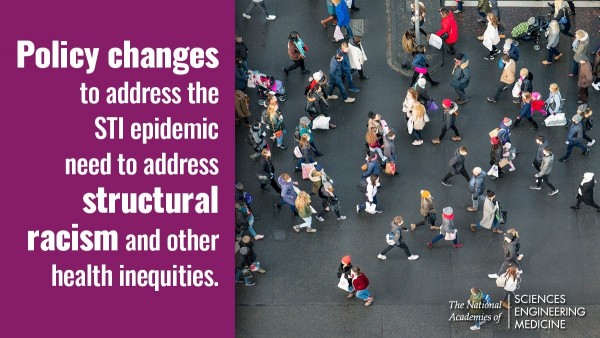On March 24, 2021, the National Academies of Science, Engineering, and Medicine released their report, “STIs: Adopting a Sexual Health Paradigm.” The report includes all levels of US society and healthcare system to identify recommendations to improve the national approach to sexually transmitted infections (STIs).
NACCHO is sharing a series of blog posts to highlight some of the recommendations that are particularly important for local health departments (in case you have not yet had time to read the 750+ pages!).
Recommendation 9-1 of the report encourages the development of a “whole-of-government approach, in partnership with affected communities, to promote sexual health and tackle structural racism and inequities that are barriers to STI prevention, testing, and treatment.” This includes specifically the need to “acknowledge structural racism and other forms of structural inequities as root causes of STI outcomes and inequities and as threats to sexual health.” While this recommendation is specifically focused on the federal government, it certainly applies in the local government and health department setting as well. Simply taking the prevention and treatment approaches that we have historically used is not enough—with the increase in funding that we all know is needed and indicated as mandatory in the report. All parts of the local government, even those outside of the health department, have an incredibly important role in addressing the community level circumstances and inequities that put an individual at heightened risk for STIs. Factors such as housing stability and basic income can both impact access to STI and other healthcare services and without them can directly cause individuals to be in “high-risk” situations such as having to exchange sex for housing or food. Similarly, the stigma associated not just with STIs but with the factors that increase one’s risk for STIs. These stigmas negatively impact the healthcare seeking of many communities and if the community is not engaged in regular healthcare, we have lost one of our most powerful tools to address STIs—both as far as prevention and treatment.
This aligns with the NASEM Report’s Recommendation 12-5 which was discussed in our prior blog post— “improve coordination and strengthen population outcomes by supporting local stakeholder engagement processes to develop and implement local plans for STI control.” Local health departments will lead these efforts to create local plans but as Recommendation 9-1 points out, it must be an effort that engages all levels and parts of the local government and has active engagement by the local community. Engagement cannot just sit in a government building nor can it ignore the broad needs of those deemed “at high risk.” Instead, we must consider all the elements that contribute to “risk” and come together actively with our community to better understand how to tackle them all. Only with that holistic, community-driven approach can we successfully combat STI outcomes and inequities.
At NACCHO, we are actively thinking about how to support you in this effort, and we hope that you will start thinking about what a comprehensive, “whole-of-government” plan to address STIs and structural racism would look like in your community—either in conjunction with an Ending the HIV Epidemic plan or not.
Want to chat about this or other items from the NASEM report? Reach out!



